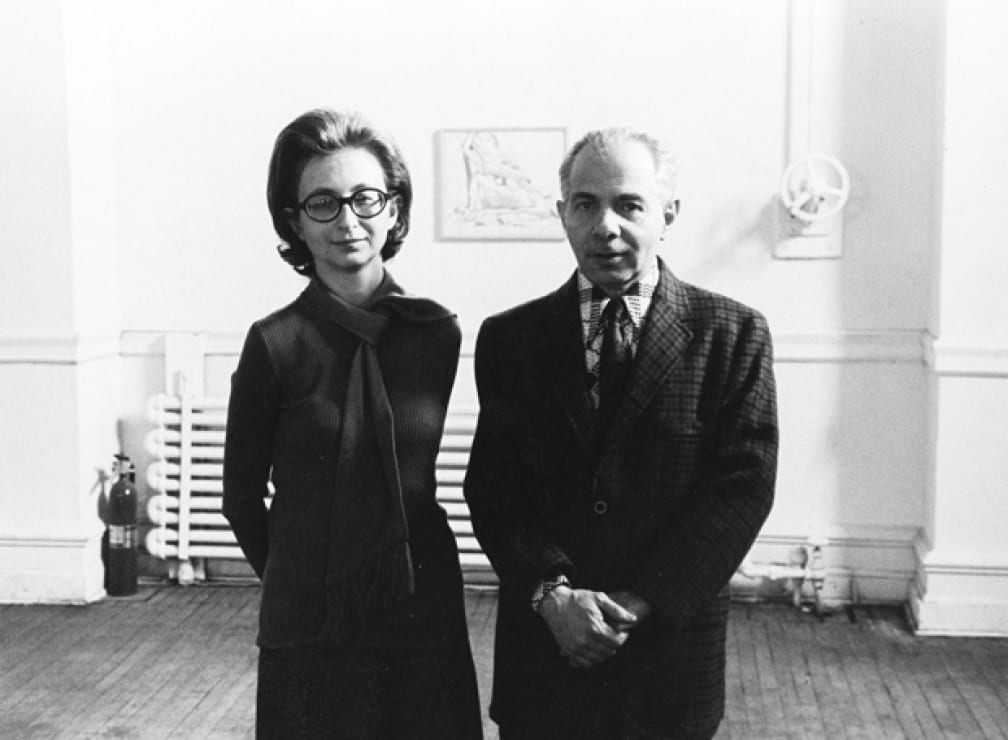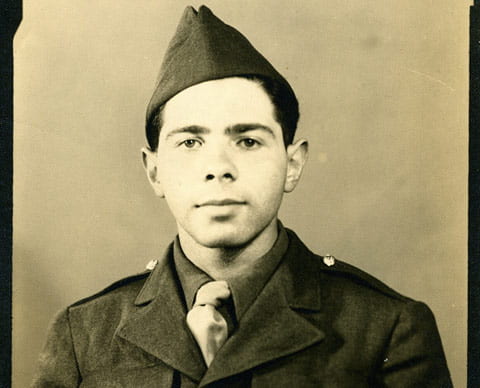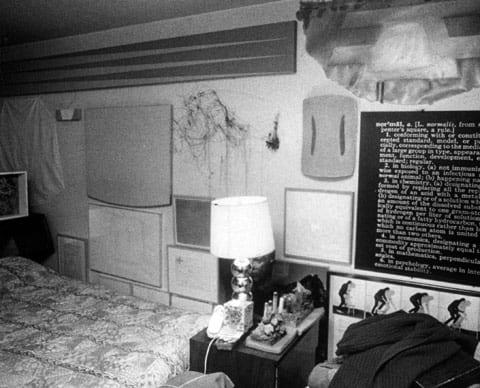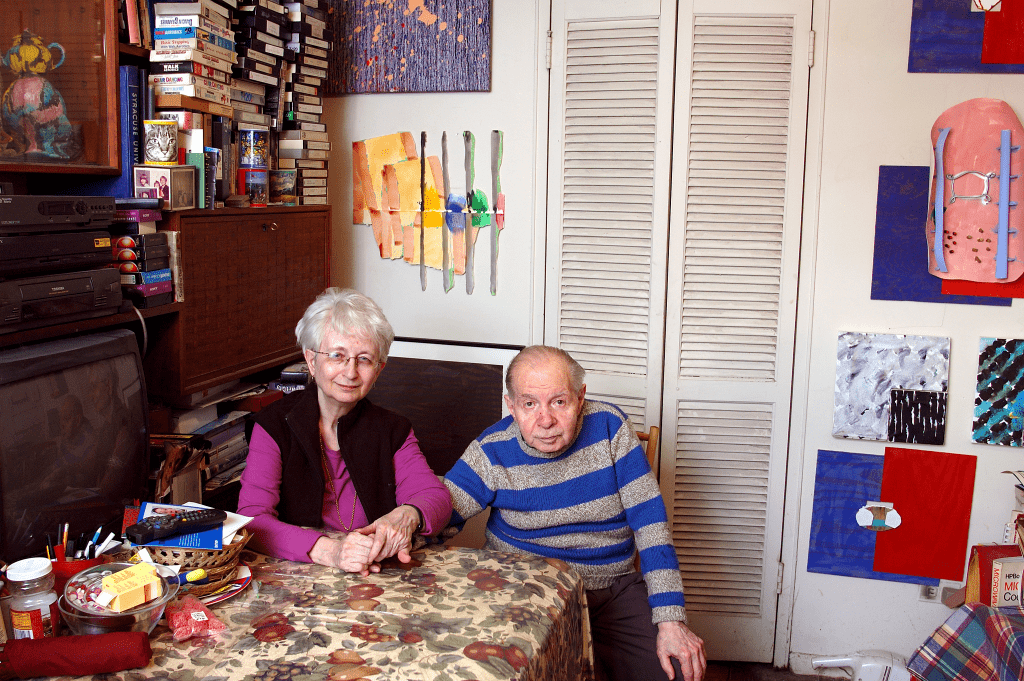
Guest post by Julia Kilgore.
When I first heard that Dorothy Vogel was coming to the Bloomington campus, I remembered that all I knew about her was that she and her husband, Herbert Vogel, were well-known art collectors who had donated thousands of pieces to various museums across the United States. As I sat down for my interview with Mrs. Vogel, I was not sure what to expect. I’d watched the documentary Herb & Dorothy and read articles with intriguing headlines like “The Unlikely Medici: A Pair of Art Fans Assemble What May Be the ‘Premier Collection’ of Its Type” and “How a Working Class Couple Amassed a Priceless Art Collection.” Although people often think that art collecting primarily concerns money, I soon discovered that for this unusual collector it was about her joy for collecting artwork with her husband as well as the couple’s personal relationships with the artists.

An Introduction to the Vogels:
Herbert Vogel, known by some as Herb or Herby, was the son of a Russian Jewish garment worker from Harlem. After serving in the army during World War II, Herbert worked nights as a clerk sorting mail for the U.S. Postal Service. His wife, Dorothy (née Hoffman), was the daughter of an Orthodox Jewish shopkeeper from Elmira, New York, and worked as a reference librarian at the Brooklyn Public Library.
The Vogels met in 1961 at a reunion for guests of a summer resort. They married a year later and quickly began acquiring works by previously undiscovered or underappreciated artists, such as Richard Tuttle, Sol Lewitt, and Robert Mangold. Sadly, Herbert passed away in 2012.

The Interview:
The Vogels and Their Relationship with Art
Originally, Mrs. Vogel wasn’t very interested in art. She attributes much of her love for art and collecting to her relationship with her husband.
Dorothy: “When I was going to school for library science I didn’t know anything about art. I only got interested when I met my husband. Even when we were dating, we went out to dinner and movies but not to galleries or museums. When we got married, right away he started taking me to various museums. On our honeymoon to Washington, one of the first places we visited was the National Gallery. That’s where I started learning about art. I learned about art by looking at it, and to this day I never have read a textbook on art history. I have gone to a lot of lectures and I have talked to a lot of artists about their work, but I never took a course in art history. I was more interested in painting and going to galleries, and with a full-time job I didn’t have time to take a course in art history. I learned a lot along the way. You get a better perception of what art is about by looking at it directly.”
Dorothy met Herbert while he was painting and taking courses at NYU. His passion for art ignited something in Dorothy and soon after they got married she also began taking courses at NYU. Both had the goal of one day becoming professional artists, and their personal creations were plastered all over their apartment.
As the years went by, however, more and more works by other artists began to find a place on their walls, and the Vogels soon realized that they had a passion for collecting.
Dorothy: “One day we looked up and realized that the other artists were better than we were and that we were better at collecting than painting.”

Thus, they devoted their lives to collecting, and their humble, one-bedroom New York City apartment became a kind of private museum. Since they had full-time jobs, they had to collect during the evenings and on weekends. Dorothy’s salary paid their living expenses, while Herbert’s income fueled their collecting.
Dorothy: “All of our spare time was devoted to it. It was something my husband and I shared. We loved what we were doing. We seemed to agree on what we liked in many cases. Not always though. My husband liked things that were more flamboyant and I tended to like things that were more cerebral, but we respected each other’s vision. We enjoyed it so much.”
One of the primary focuses of the collection was up-and-coming artists.
Dorothy: “We knew a lot of these artists who were doing the minimal art at the time…Their work was not really accepted quickly. They were shown more in Europe than in the United States because people at that time were more interested in Abstract Expressionism and Pop art…so we had no competitors because no one was interested and so we were able to buy a lot of their work.”
The Vogels and Sol Lewitt
Herbert and Dorothy were interested not only in buying the art but also in getting to know the artists personally. Mrs. Vogel spoke at length about her interactions with artists—about having them over for dinner, seeing them at gallery openings, or visiting them in their studios. Among the many individuals Mrs. Vogel mentioned, one in particular came to the forefront: Sol Lewitt.
Dorothy: “So we got to know these artists and when you get to know them, you get to know their work better…We were very close to Sol Lewitt. I think we were the first to buy his work. Herby and I were going to galleries and we were at Leo Castelli’s gallery and Sol Lewitt was there. Herby had met him years before through another artist. I was introduced to Sol at that time and he said he was going to have an exhibition at the John Daniels Gallery and asked if we would go and see it. At that time there weren’t many galleries that were dealing in that type of art so our ears perked up. So right after we saw him, we went straight to that new gallery. Later on, we saw Sol’s show there. [His] works were quite radical. There were structures in different colors and they were very minimal. It took us a while to get adjusted to it because it was so different.”
Throughout the years, the Vogels continued to keep in touch with Sol. In fact, Herby would call him every Saturday.
Their interactions with Sol also allowed the couple to get to know his assistant, Susanna Singer, whom Dorothy fondly refers to as Sol’s “gatekeeper.”
Dorothy: “If you wanted to reach Sol, you’d have to reach Susanna.”
After both Herby and Sol passed away, she and Susanna began talking every Saturday. She became a lifelong friend to Dorothy and to this day accompanies her on her trips. The director of the documentary Herb & Dorothy, Megumi Sasaki, whom the Vogels met at the Gracie Mansion in New York, is another of Dorothy’s frequent traveling companions.

Becoming Arts Philanthropists
The couple’s collection eventually became so vast that they became philanthropists, first donating works to the National Gallery of Art in Washington, DC, and then giving fifty works to museums in fifty states, including to the Indianapolis Museum of Art.
Dorothy: “We never got storage space because we wanted complete control of what we had. It wasn’t until the National Gallery came and started taking the work away that we realized how much we had.”
She also didn’t want to do it alone.
Dorothy: “When Herb died, I decided that I didn’t want to collect without him. It was our collection and I didn’t want to water it down. It had to have his imprint on it, so I gave it up.”
As far as she was concerned, the collection was complete.
The IU Cinema will show the documentary Herb & Dorothy as part of the Art and a Movie series on Sunday, November 12, 2017, at 3 p.m. Most exciting of all is that following the movie, Dorothy Vogel will be present for a post-screening conversation with the director of the Eskenazi Museum of Art, David Brenneman.
These programs are presented in partnership with the Eskenazi Museum of Art and are sponsored by Marsha R. Bradford and Harold A. Dumes. This partnership is supported through IU Cinema’s Creative Collaborations program.


Julia Kilgore is currently completing a dual masters in Library Science and Art History at Indiana University. As a graduate assistant for the Eskenazi Museum of Art and a student worker at the Indiana University Archives, she loves to see how art, film, and archives coincide and continually inspire those who interact with these materials.